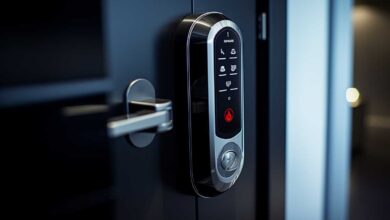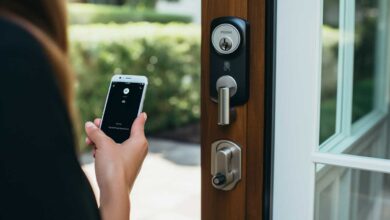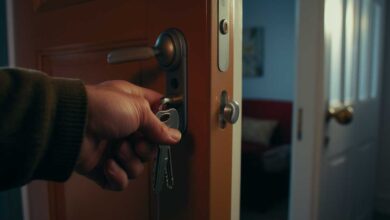Preventive Maintenance For Home Locks: Top Tips
KEY TAKEAWAYS
In home security, we often prioritize the latest security systems, overlooking the basics – our locks. Locks, after all, are the first line of defense against intruders. Like other equipment, they require regular care to function effectively and reliably.
This article delves into the vital practices that will ensure your locks remain robust and dependable and serve their purpose for years. Whether you’re a homeowner seeking peace of mind or simply someone looking to prolong the life of their door hardware, this guide provides essential insights for optimal lock care.
Benefits of Lock Maintenance
-
Enhances lock performance and prolongs its lifespan.
-
Prevents costly replacements, saving homeowners money.
-
Ensures locks function properly, boosting home security.
Key Points on Maintenance:
-
Locks can jam or become hard to turn due to wear. Routine checks and using dry lubricants can prevent these issues.
Outdoor locks need extra care:
-
Prevent rust with rust prevention products.
-
Mitigate freezing risks in extreme weather.
Consistent lock maintenance brings improved performance, longevity, and cost benefits.
Attention to outdoor lock care ensures enhanced security and peace of mind.
Professional Locksmiths
Ensuring the functionality and security of residential locks necessitates the expertise of professional locksmiths. These specialists possess profound insights into lock systems and carry the essential tools for addressing lock challenges. Beyond just installation and repair, locksmiths impart crucial guidance on lock maintenance, ensuring homeowners’ peace of mind.
Services Offered by Professional Locksmiths:
-
Lock Inspection: A preventive step to spot wear or damage. Skilled locksmiths evaluate whether a lock requires repair or replacement.
-
Lock Repair: Addressing malfunctions efficiently, be it realigning, lubricating, or replacing components.
-
Lock Replacement: Essential when a lock is irreparable or an upgrade is desired. Locksmiths guide and implement suitable lock systems based on security needs.
In essence, relying on locksmiths guarantees accurate problem diagnosis, valuable maintenance advice, and overall heightened home security. Utilizing their comprehensive services ensures both the integrity of locks and homeowner peace of mind.
Cost Considerations for Residential Lock Maintenance
Maintaining residential locks involves several financial considerations. Regular upkeep not only ensures optimal function and longevity but also leads to significant long-term savings. Key points include:
-
Avoiding Emergency Services: Frequent inspections can prevent unexpected failures, eliminating the costly need for emergency locksmiths, who often charge premium rates outside standard hours.
-
Minimizing Replacement Needs: Properly maintained locks reduce the risk of severe issues necessitating full replacements, which are pricier than routine check-ups.
-
Investment in Quality Hardware: Using high-grade strike plates, solid core doors, and protective coatings can lessen the need for regular maintenance and extend lock life.
-
Advanced Door Hardware: Systems like biometric readers and keypads boost security and typically require less upkeep than traditional locks.
In essence, although there’s an upfront cost for preventive lock maintenance, the long-term financial benefits, from avoiding emergencies to reducing replacements, justify the investment.
Internal Components and Their Importance
For residential locks, understanding the significance of regular maintenance is paramount to thwart unexpected malfunctions and avert costly emergency locksmith visits. Central to this is monitoring the lock’s internal components.
As these parts age, they can deteriorate or misalign, compromising functionality. Recognizing and rectifying wear or misalignment ensures locks work seamlessly and securely. Such preventive attention not only prolongs the lock’s lifespan but also forestalls expensive emergencies and untimely replacements.
Signs of Wear and Tear on Locks
Door locks, vital for home security, inevitably face wear and tear that can risk security. Recognizable signs include:
-
Loose screws: Can destabilize locks, facilitating tampering.
-
Misaligned latches: This may hinder effective lock engagement.
-
Worn-out keys: Pose turning difficulties or could break within the lock.
Untreated issues lead to vulnerabilities, risking unauthorized access and resident safety. Regular maintenance, like tightening screws, realigning latches, and replacing worn keys is pivotal. Additionally, lubricating locks aids in smooth operation and enhance longevity. Timely maintenance ensures security and safeguards households.
Dry Lubricants for Lock Prevention
Using dry lubricants, like graphite powder or Teflon-based sprays, can greatly preserve residential door locks:
-
Graphite powder: Offers friction reduction for interior locks shielded from moisture and dirt.
-
Teflon-based sprays: Prevent rust, making them apt for outdoor locks.
Regular applications of these lubricants reduce internal wear, preventing malfunctions and prolonging lock life.
Oil-Based Lubricants for Restoration
Oil-based lubricants differ from dry alternatives by aiding restoration. Key benefits include:
-
Penetrating Power: They seep into tight spaces, freeing rusted or stuck parts.
-
Protection: They offer a protective layer against further corrosion.
Oil-based lubricants are essential for locks exposed to moisture or harsh conditions, ensuring continued functionality and added lifespan. Proper maintenance, lubrication, and timely restoration are indispensable for residential lock longevity and performance.
Excess Lube Considerations
For lock maintenance, applying the correct lubricant amount is vital. Over-lubricating can attract dirt, leading to lock malfunctions or stickiness. This buildup might make locks difficult to operate.
Lubricant overflow can also leave residue on adjacent areas like the strike plate, drawing more dirt. Always adhere to manufacturer guidelines or consult a locksmith to ensure correct application. Proper lubrication enhances lock performance and prevents dirt-related issues.
Hinge Pin Adjustment and Alignment
Maintaining residential lock function is key for home security. A vital but overlooked step is hinge pin adjustment. Misaligned hinge pins can cause lock sticking or looseness, compromising door security.
To adjust, tighten hinge screws on the door and frame, ensuring firm attachment. Check for smooth door movement; if there’s any sticking, realign hinge pins. Regular adjustments prolong the lock’s lifespan and boost security. For uncertainties or difficulties, consult a locksmith. Regular hinge pin care ensures optimal lock performance and security.
External Components
Attending to the external components of residential locks is vital. Over time, parts like strike plates and lock bodies can wear out or rust, compromising security. Regularly Inspect these components for damage or misalignment and promptly repair or replace them as needed.
A protective coating or lubricant can ward off rust and boost performance. Proper maintenance of these external parts ensures long-lasting, effective locks, giving homeowners enhanced security and peace of mind.
Strike Plates and Strike Hole Alignment
Strike plates and strike hole alignment are vital for residential lock function, ensuring smooth latch or deadbolt engagement and maximum security. Misaligned plates can compromise the lock, risking break-ins.
Adjust by tightening screws or modifying the hole. Ensure the deadbolt and dead-latch align and operate without resistance. The fit-gap between the lock bolt and strike plate should be optimal to prevent wear. Regularly maintain and inspect these components to ensure lock efficiency and bolster home security.
Extreme Weather Considerations
Strike plates and strike hole alignment are vital for residential lock function, ensuring smooth latch or deadbolt engagement and maximum security. Misaligned plates can compromise the lock, risking break-ins.
Adjust by tightening screws or modifying the hole. Ensure the deadbolt and dead-latch align and operate without resistance. The fit gap between the lock bolt and strike plate should be optimal to prevent wear. Regularly maintain and inspect these components to ensure lock efficiency and bolster home security.
Heavy-Duty Rust Removal
For heavy-duty rust removal from locks, use white vinegar. Remove the lock, disassemble it to expose rusted parts, and submerge it in vinegar, leveraging its acetic acid to dissolve rust. After soaking, gently scrub the rust off with a soft-bristle brush. Rinse, let dry, and apply a protective coating to prevent future rust. This method restores lock functionality and extends its lifespan.
FAQs
1. Can any type of vinegar be used for rust removal?
White vinegar is preferred due to its acetic acid content, effectively breaking down rust.
2. How long should the lock soak in the vinegar solution?
For optimal results, it’s best to soak for several hours or overnight.
3. Is it essential to disassemble the lock before soaking?
Disassembling exposes all rusted parts, making the process more effective.
4. What protective coatings are best for preventing future rust?
Lubricants or anti-rust sprays designed for metals or locks are recommended.
5. Will the vinegar method damage the lock’s internal components?
No, but ensure you rinse the lock thoroughly and let it dry completely afterward.
Conclusion
Rust removal from residential locks ensures security and prolongs their usability. Using white vinegar, a natural and effective solution, homeowners can restore their locks’ functionality. It’s vital to treat rusted locks promptly, and with appropriate post-treatment care, further rusting can be prevented, keeping locks in optimal condition.
Are you wondering where to find a 24/7 locksmith incase of emergencies? Read more about your options from our blogs at Security Forward.





